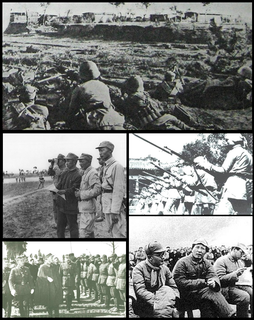| Tianjin Campaign | |||||||
|---|---|---|---|---|---|---|---|
| Part of the Chinese Civil War | |||||||
| |||||||
| Belligerents | |||||||
National Revolutionary Army | People's Liberation Army | ||||||
| Commanders and leaders | |||||||
| Strength | |||||||
| 130,000 | 340,000 | ||||||
| Casualties and losses | |||||||
| all killed or captured | 7,030 killed, 19,214 wounded | ||||||
The Tianjin Campaign was the epitome of the Pingjin Campaign, and it was fought between the nationalists and the communists during the Chinese Civil War in the post-World War II era. The result of the Tianjin Campaign helped to determine the outcome of Pingjin Campaign.
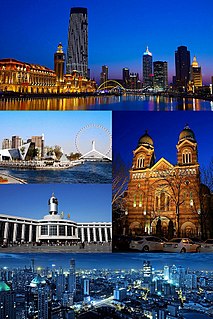
Tianjin, formerly romanized as Tientsin, is a coastal metropolis in northern China and one of the nine national central cities of the People's Republic of China (PRC), with a total population of 15,621,200 as of 2016 estimation. Its built-up area, made up of 12 central districts, was home to 12,491,300 inhabitants in 2016 and is also the world's 29th-largest agglomeration and 11th municipality-most populous city proper.
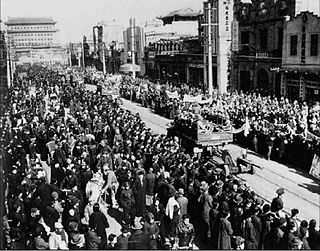
Pingjin Campaign, also known as the Battle of Pingjin, was part of the three major campaigns launched by the People's Liberation Army during the late stage of the Chinese Civil War against the Nationalist government. It began on 29 November 1948 and ended on 31 January 1949, lasting a total of 64 days. This campaign marked the end of Nationalist dominance in the North China Plain. The term Pingjin refers to the cities Beiping and Tianjin.
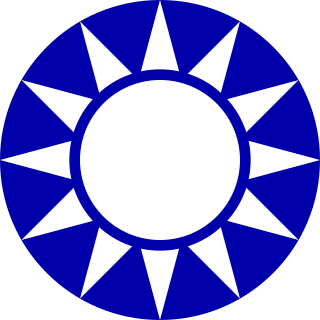
The Kuomintang of China is a major political party in the Republic of China on Taiwan, based in Taipei and is currently an opposition political party in the Legislative Yuan.
Contents
The original communist plan was to take Tanggu first to cut off the nationalist escape route via ocean and then force the nationalists in Beijing and Tianjin to surrender, in order to save the two historical cities from the destruction of the war. However, the nationalist resolve to defend the cities to the end was strong and reconnaissance had revealed the sounding regions of Tanggu was not suitable for building fortifications and deploying assaulting forces, and the region strongly favored defenders. The communists were forced to change their plan by attacking Tianjin first. According to the geography of Tianjin, which was characterized in its long span in the north-south direction and short span in the east-west direction, the communists made a plan of simultaneously attacking from the east and west, cutting off the city in the middle, and then first taking the southern portion of the city, and afterward taking the northern portion of the city.
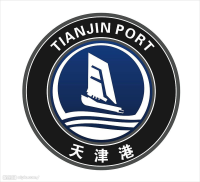
The Port of Tianjin, formerly known as the Port of Tanggu, is the largest port in Northern China and the main maritime gateway to Beijing. The name "Tianjin Xingang", which strictly speaking refers only to the main seaport area, is sometimes used to refer to the whole port. The port is on the western shore of the Bohai Bay, centred on the estuary of the Haihe River, 170 km southeast of Beijing and 60 km east of Tianjin city. It is the largest man-made port in mainland China, and one of the largest in the world. It covers 121 square kilometers of land surface, with over 31.9 km of quay shoreline and 151 production berths at the end of 2010.

Beijing, formerly romanized as Peking, is the capital of the People's Republic of China, the world's third most populous city proper, and most populous capital city. The city, located in northern China, is governed as a municipality under the direct administration of central government with 16 urban, suburban, and rural districts. Beijing Municipality is surrounded by Hebei Province with the exception of neighboring Tianjin Municipality to the southeast; together the three divisions form the Jingjinji metropolitan region and the national capital region of China.
From January 3, 1949 through to January 12, 1949, the communists cleared all 18 nationalist strongholds outside the city, and the defenders were forced to take refuge behind the city wall. After the nationalists behind the city wall had refused to surrender for three times when asked, the communists launched their final offensive on the city on January 14, 1949 at 10:00 AM. After 29 hours of fierce fighting, the entire besieged nationalist garrison of the city totaling more than 130,000 was completely annihilated, and Chen Changjjie (陈长捷), the nationalist commander-in-chief of the defense, was captured alive along with many of his subordinates, including his deputy, Major General Qiu Zongding (秋宗鼎), the deputy commander-in-chief of nationalist Tianjin Garrison, Major General Yang Wei (杨威), the chief-of-staff of the nationalist force defending Tianjin, Major General Li Yeqing (李叶清), the secretary-general of nationalist headquarter in Tianjin, and Major General Cheng Zijian (程子践), the nationalist inspector-general from Nanjing, hand-picked personally by Chiang Kai-shek himself. With the exception of the 7th Chinese Textile Factory, which was completely destroyed in the final offensive, most of the rest of the infrastructure of Tianjin was captured intact. The price paid by the attacking communist force is relative low in the campaign, suffering a casualty rate that include 7,030 killed, and 19,214 wounded, without any missing or being captured. Among those communists killed were several hundred Japanese troops of the former-Japanese Imperial Army, who stayed in China after World War II and joined the communists.
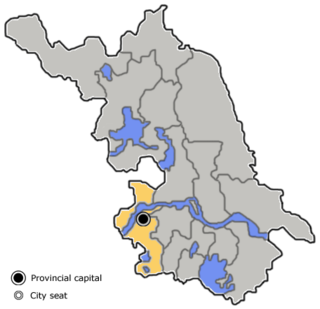
Nanjing, formerly romanized as Nanking and Nankin, is the capital of Jiangsu province of China and also the second largest city in the East China region, with an administrative area of 6,600 km2 (2,500 sq mi) and a total population of 8,270,500 as of 2016. The inner area of Nanjing enclosed by the city wall is Nanjing City (南京城), with an area of 55 km2 (21 sq mi), while the Nanjing Metropolitan Region includes surrounding cities and areas, covering over 60,000 km2 (23,000 sq mi), with a population of over 30 million.

Chiang Kai-shek, also known as Generalissimo Chiang or Chiang Chungcheng and romanized as Chiang Chieh-shih or Jiang Jieshi, was a Chinese politician and military leader who served as the leader of the Republic of China between 1928 and 1975, first in mainland China until 1949 and then in Taiwan until his death. He was recognized by much of the world as the head of the legitimate government of China until 1971, during which the United Nations passed Resolution 2758.


